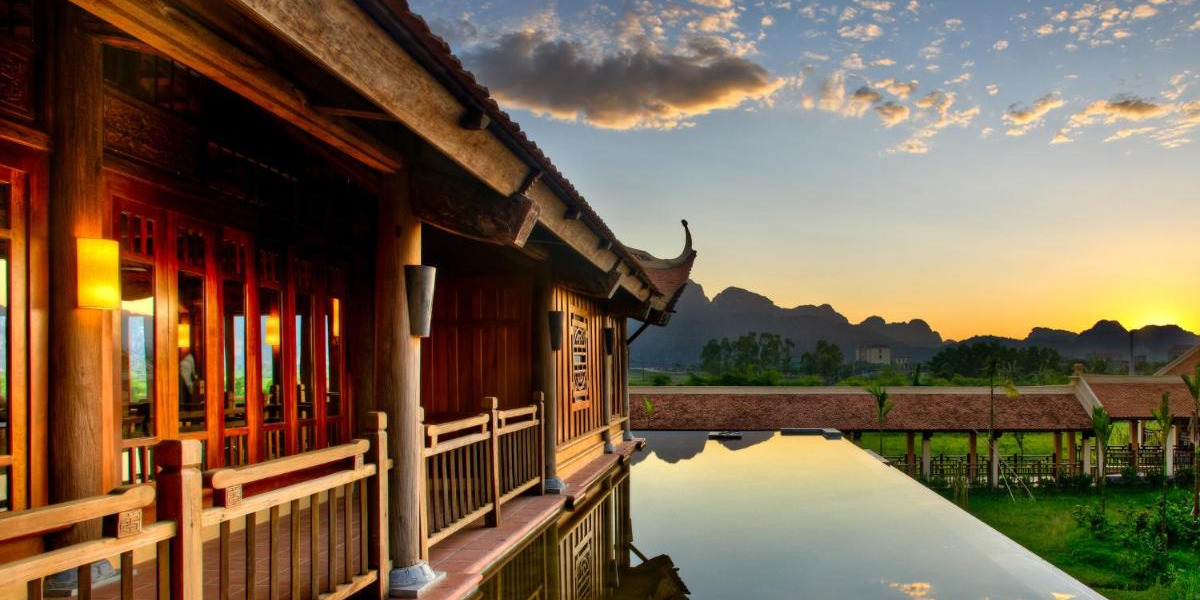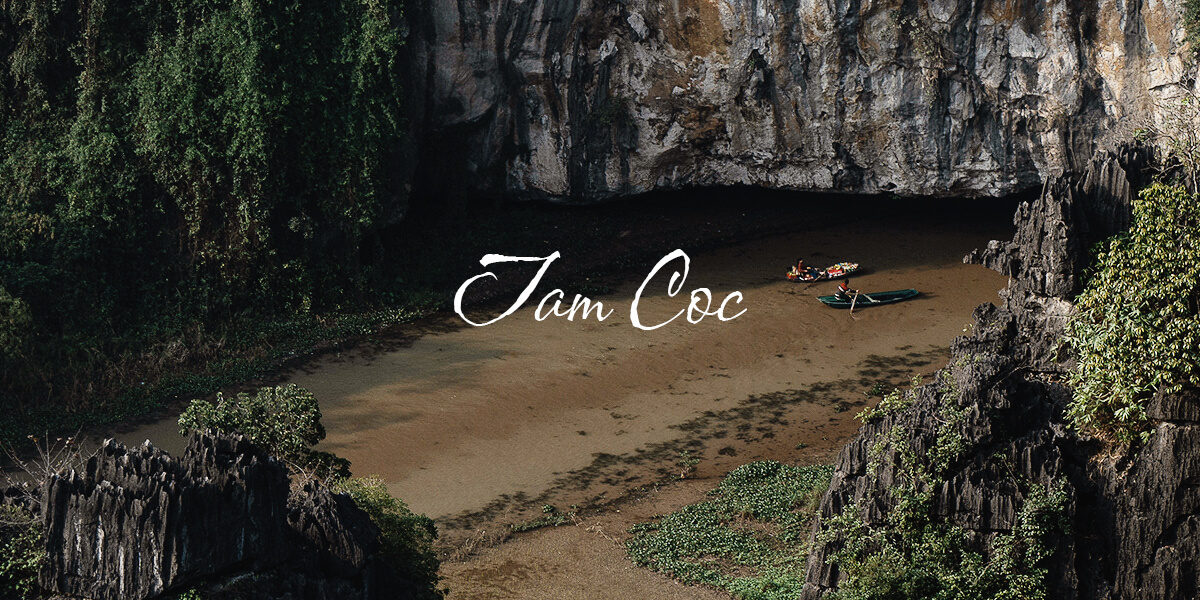Bai Dinh pagoda in Ninh Binh is well-known for its remarkable records such as the largest bronze Buddha statue in Asia, the highest Stupa in Asia, the two largest bells in Asia, the longest Arhat corridor in Asia, ... This used to be the place to hold the Grand celebration of Buddha relics from India to Vietnam in 2010. Every year, this pagoda welcomes millions of visitors to come, especially in spring.
I - How to get to Bai Dinh Pagoda?
Bai Dinh bus station is located in Bai Dinh - Cuc Phuong street, Gia Sinh commune, Gia Vien district, Ninh Binh province. From the parking lot, you walk a few tens of meters to the reception area, where you can find the direction and more information about the pagoda and buy electric tourist car tickets to visit the pagoda. The Bai Dinh pagoda electric cars depart from the reception area and stop at the parking area about 100m from Tam Quan External gate.
Electric tourist car ticket: 30,000 VND / person / way ($1.3)
From Hanoi to Ninh Binh: Booking a limousine is the best choice to save time and explore the famous Ninh Binh attractions such as Bai Dinh pagoda, Trang An complex landscape and Tam Coc in one day.
II - How to explore Bai Dinh pagoda?
In order to easily track and schedule a visit, Local Travel Idea divides the Bai Dinh complex into 6 areas (according to the increasing height). You can follow this exploring-ordered direction:
- Area 1 - Tam Quan gate
- Area 2 - Belltower
- Area 3 - Quan The Am hall
- Area 4 - Phap Chu hall
- Area 5 - Tam The hall
- Area 6 - Ancient Bai Dinh pagoda

6 areas in Bai Dinh - Source: Internet
Areas 1 to 5 are connected by Arhat corridors consisting of 500 Arhat monolithic statues. Each statue is 2.5m high, including the pedestal, with different shapes, manners and postures.
Note:
- Do not place money or touch the statues.
- Bai Dinh pagoda entrance fee: free
- Opening hours: 6am - 10pm
1 - Area 1: Tam Quan gate
There are two gates: The External gate and The Internal gate. Tam Quan External gate is about 100m from the electric-car parking. The gate is made of reinforced concrete with a curved roof. Walking through The External gate, you enter a paved road along two crystal-clear lakes leading to Tam Quan Internal gate of Bai Dinh pagoda Vietnam.
Being made from Tu Thiet woods (including the 4 most valuable wood trees in Vietnam: Iron-wood, Lauan Meranti wood, Apitong wood and Dysoxylum cauliflorum wood), the Tam Quan Internal gate has a three-story roof bent to 4 sides and covered with glazed tiles. Step through this gate, you see 2 statues of Dharmapala (Trung Ac Dharmapala and Khuyen Thien Dharmapala) made of bronze, each weighing up to 12 tons.
From the western and eastern sides of Tam Quan Internal gate of Bai Dinh pagoda, the old wooden house system can be seen with 16 rooms and 4.5m long on each side. The 70-meter wooden houses are connected with the Arhat corridors on both sides.
2 - Area 2: Bell tower
The 22m high Bell tower, consisting of a three-story curved roof and having an octagonal structure with 24 curved roofs, looks like a giant lotus flower. On the first floor of the bell tower, a bronze drum weighing up to 76 tons is cast in the form of the Dong Son bronze drum (a famous type of ancient bronze drum created by the Dong Son culture in Vietnam with unique patterns). On the second floor, there is a 36-ton bell that is identified as the largest bronze bell in Vietnam.
3 - Area 3: Quan The Am hall in Bai Dinh pagoda
Walking from the bell tower area throughout the beautiful flower garden, you come to Quan The Am hall (Bodhisattva Avalokitesvara hall). The temple consists of 7 compartments roofed with Bat Trang ceramic tile and entirely made of Tu Thiet wood.
A 9.57m high and 80-tons weigh thousand-eye Bodhisattva Avalokitesvara statue, cast with gold-plated bronze, is placed in the middle of the temple. It is considered the largest bronze statue of Bodhisattva Avalokitesvara in Vietnam. The three middle compartments have 3 horizontal lacquered boards and 3 hanging “Cửa Võng” (a type of door in the shape of the letter "M", made of wood and sophisticatedly sculpted and engraved with a pattern of a dragon's head).

Quan The Am Temple in Bai Dinh pagoda in Ninh Binh - Source: Mapio
There are many unique bronze-made worshipping items, and a wooden altar with sophisticated carvings of four holy creatures, four seasons, and flowers. There is a 63m wide and 77m long lake namely Phong Sinh Lake next to the Bodhisattva Avalokitesvara temple.
4 - Area 4: Phap Chu hall
Through Phong Sinh Lake, there is a large paved courtyard, leading to Phap Chu hall (Buddha Dharma lord temple). It is famous for the statue of Shakyamuni, which was confirmed as "The tallest and heaviest bronze statue of Shakyamuni in Vietnam" in 2006. The highlights inside this hall in Bai Dinh pagoda are a 10m high & 100-ton weigh bronze statue and Vietnam’s largest 3 horizontal lacquered boards and 3 hanging “Cửa Võng” which are exquisitely carved from valuable woods.
After visiting Phap Chu hall, you visit the 13-story Stupa. The Ly Dynasty architectural style Stupa is covered on the outside with Bat Trang baked bricks and decorative patterns such as clouds, water waves, lotus petals,...
Inside this Stupa of Bai Dinh pagoda Vietnam, there is a Buddha Shakyamuni statue made of brilliant gold-plated copper, a bluestone altar sophisticatedly carved with patterns of dragons, lotus flowers and mascots. The reliefs on the wall depict the Buddha's life from his birth to his righteous practice.
The 13th floor of the stupa is where the Buddha's relics (from India, Thailand and Myanmar in 2008) were placed. To reach the top of the tower, you can go up the stairs to admire the elaborately carved stone relief system or take the elevator to save time.
Tickets to visit the tower are VND 50,000/person (~ $21.5).
5 - Area 5: Tam The Hall of Bai Dinh pagoda
Tam The hall (The Three-period hall) is located on a hill 67m higher than the Tam Quan gate. From the courtyard in front of the hall, you can follow one of two ways to Tam The building, each 8m wide, including 32 stone steps. Between the two entrances, there is also a large square stone relief carved with four spirits (dragon, qilin, turtle, phoenix). On both sides of that stone relief, there are two large stone dragons, 10m long, carved with beautiful pine trees and ball canals.
Tam The hall has 3 floors, including 12 curved roofs on four sides. The roof is covered with dark brown glazed ceramic tiles from Bat Trang pottery village, curved up like a phoenix tail.

Tam The hall in Bai Dinh pagoda Ninh Binh - Source: Internet
Inside the Tam The hall, the 3 monolithic bronze Three Periods statues in size of 7.2m high & 50-ton weight are all inlaid with gold and placed on three 1.5m stone pedestals carved with impressive patterns. These 3 statues were confirmed by the Vietnam Records Book Center as "the largest set of bronze Tam The statues in Vietnam" on December 12, 2007.
Located on a 100m high hill on the left side of Tam The Temple, there is a huge Maitreya Buddha statue. The 80 tons & 10m high statue is recognized by Vietnam Records Book Center - Vietkings as the largest Maitreya statue in Vietnam.
6 - Area 6: ancient Bai Dinh pagoda
The last area of the pagoda complex is the ancient pagoda. Located on Dinh mountain, it is about 800m from Tam The Hall to the South.
This pagoda is not famous for the stunning curved roofs, the massive pillars or the magnificent worshipping halls like the new pagoda. The ancient pagoda impresses you with the unique cave-pagoda concept architecture. All altars are placed in the cave, amplifying the sacred and mysterious atmosphere.
Well of Jade
At the foot of Dinh mountain, there is an ancient well called Well of Jade-recorded as the largest well in Vietnam. Legend has it that this is the place where Zen master Nguyen Minh Khong took the decoction of medicine for the people. The clear blue well in Bai Dinh Pagoda Ninh Binh never runs out of water.
Light Cave - Dark Cave
After visiting Well of Jade, you will climb about 300 stone steps to reach Bright Cave, Dark Cave, and the front house. The works of Buddha statues, altars and incense tables are all placed inside the caves.
In front of the caves, there is an ancient stone-carved poem written by King Le Thanh Tong (1442 - 1497) to praise the beauty of the pagoda.
After visiting the ancient pagoda, visitors move down and follow the Arhat corridor to go to the electric car station near the external Tam Quan gate to return.
III - Other information
1 - Bai Dinh pagoda history
The ancient pagoda was built in 1136 by Zen master Nguyen Minh Khong. Legend has it that, on the journey to find medicinal plants for King Ly Than Tong (1116 - 1138), the Zen master found a cave on Dinh mountain and decided to build a pagoda and a Buddha statue. After nearly a millennium, the ancient pagoda still exists, representing the enduring vitality of Buddhism in the spiritual life of Vietnamese people.
The new pagoda area was built in 2003 with a large scale and extremely majestic but still expressing the unique Vietnamese Buddhist architecture.
2 - Bai Dinh pagoda festival

Source: Internet
The festival opens from the 6th day of the Lunar New Year to the end of March and consists of 2 parts. The ceremony includes the rituals of burning incense, procession, etc. The other activities include folk games, musical performances recreating the rituals of sacrifice to the heavens of King Dinh Tien Hoang and King Quang Trung.
3 - Bai Dinh pagoda hotel
Some recommended accommodations:
- 3-Star Bai Dinh Hotel (located in the 4th area of the pagoda), price ranges from VND 1,000,000 - 1,500,000 (~ $43 - 65); contact 02293868789.
- 4-Star Bai Dinh Garden Resort and Spa (located in the 5th area), price ranges from VND 1,500,000 - 2,000,000 per night (~ $64.7 - 21.6); contact 02293666689.
- Ninh Binh Mountain Side Homestay & Cafe, prices range from VND 350,000 - 1,000,000 per night (~ $15.08 - 43); Khe Thuong village, Ninh Xuan commune, Hoa Lu district, Ninh Binh province; contact: 096 86 56 69.
4 - Travel tips
- The best time to visit Bai Dinh Pagoda in Ninh Binh is from February to April because of the pleasant weather. However this is the peak time of the festival season in Vietnam, if you have children with you, you need to pay more attention.
You may need: When is the tourism season in Vietnam?
- You should prepare snacks and personal drinks in advance because the food and drinks sold in the parking area are quite expensive.
- You should bring sports shoes and a polite dress.
Bai Dinh Pagoda Ninh Binh is really a majestic pagoda and well worth a visit.







 — Giang Phạm
— Giang Phạm






















